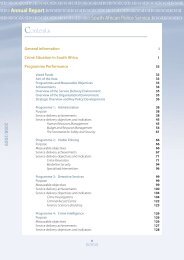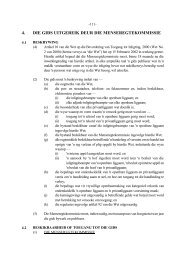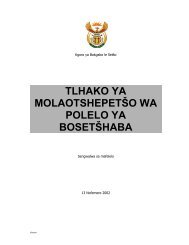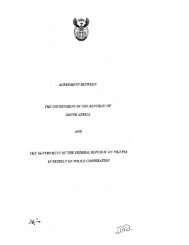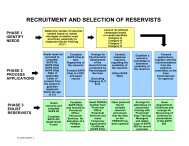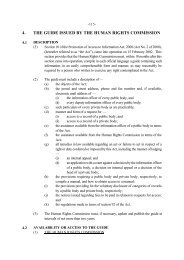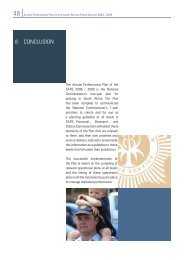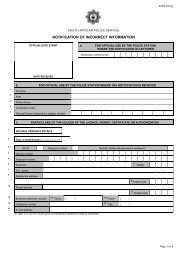Part 13 - Saps
Part 13 - Saps
Part 13 - Saps
Create successful ePaper yourself
Turn your PDF publications into a flip-book with our unique Google optimized e-Paper software.
3<strong>13</strong><br />
attacks investigated in the latter study was relatively small – only 77 cases were looked<br />
at. 12<br />
Investigated cases referred to court<br />
Cases are referred to court by the police only after a suspect has been formally charged<br />
(and, in the case of a serious offence, arrested) by the police. In essence, cases are referred<br />
to court only if there is fairly substantial evidence against a suspect to warrant the person<br />
being charged with an offence.<br />
The number of cases referred to court, as a proportion of the total number of cases<br />
recorded by the police, differ between crime types. On average just under a quarter (24%)<br />
of all cases recorded by the police are referred to court. In the Eastern Cape and fourprovinces<br />
CIAC farm attack studies referred to above, respectively 47% and 23% of farm<br />
attack cases were referred to court. (As mentioned above, the latter figure may be<br />
somewhat unreliable because of the small sample on which it was based.)<br />
The overall ability of the police to refer cases to court is high in respect of crimes where<br />
the perpetrators are likely to be known to their victims, or those that are often committed in<br />
the presence of eyewitnesses. <strong>13</strong> An above average number of murder, rape, and assault<br />
cases are consequently referred to court. However, crimes where the perpetrators are likely<br />
to be unknown to their victims, such as burglary, robbery and vehicle theft are less likely<br />
to be solved by the police and referred to court. While the South African case referral rate<br />
appears to be low, it has been reported that the police in the United Kingdom also fail to<br />
clear up about three-quarters of all offences. 14<br />
Evaluation and reasons for poor performance<br />
Personnel numbers<br />
In 1995, the newly amalgamated SAPS employed approximately 140,000 people<br />
(functional police officers and civilians). Thereafter many police officers resigned and left<br />
the service. Only a few new recruits were employed because of a hiring moratorium over<br />
much of this period. In January 2003 the SAPS was left with 129,700 employees, of which<br />
27,300 were civilians and approximately 21,000 detectives. Between late 1996 and early<br />
2003 the number of functional police officers (uniformed personnel and detectives)<br />
declined by 12%. Over a similar period, recorded serious violent crimes increased by some<br />
21%, and less serious violent crimes by some 32%. 15<br />
The medium-term expenditure framework for 2002/03–2005/06 provides for the<br />
appointment of an additional 30,200 entry-level police constables and 15,360 civilians over<br />
12 See p 351..<br />
<strong>13</strong> According to a 1997 Institute for Security Studies victims survey conducted in Johannesburg, the majority<br />
of assault, rape, and murder victims (or members of the victim’s household in the case of murder) knew<br />
the offender by name or by sight. See Louw A. et al Crime in Johannesburg. Results of a City Victim<br />
Survey (ISS Monograph Series 18, February 1998) p 23-24.<br />
14 ‘Criminal Justice: Guilty as charged’ The Economist, 9 March 2002, p 40.<br />
15 Serious violent crime: murder, attempted murder, rape, aggravated robbery, assault with the intent to inflict<br />
grievous bodily harm. Less serious violent crime: common robbery and common assault.



